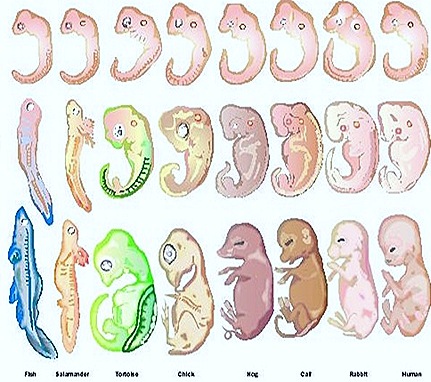Evolution-Embryology Evidences
EMBRYOLOGICAL EVIDENCES FOR ORGANIC EVOLUTION
The Study of the developmental stages of an organism is called If we observe the embryos of different animals, there is a similarity. This similarity tells us that there is a relationship between the animals. The embryological evidences show support to organic evolution.
SEQUENCE OF DEVELOPMENTAL STAGES
All multi cellular organisms begin their life as a single celled stage, namely Zygote. It undergoes cleavage to produce the first embryo, called morula. It develops into a single layered second embryo, called blastula. This embryo develops into a third embryo called gastrula. This embryo develops into adult. The Zygote represents the unicellular stage. Morula and blastula represent the colonial protozoan stages. Whereas gastrula represents the coelenterate stage. The embryos of organisms differ after the gastrula stage. The sequence of embryos shows that every multi cellular organism passes through the above stages representing their ancestors.
Zygote------ Morula------- > Blastula -------> gastrula---- adult.
(protozoan (colonial protozoan (coelenterate stage) stage) stage)
EMBRYOLOGICAL PRINCIPLES.
Von Baer proposed these principles by studying the embryology of Fish, Frog, Tortoise, Pigeon, Chimpanzee and Man. The early embryos of above animals resemble with each other closely. That it is impossible to separate if the embryos were mixed. But the embryos differ in the final stages clue to the formation of specialized characters. The similarity of early embryos tells that the above animals have common ancestors. The embryological principles are
1. General characters appear in the early embryos.
2. The special character appear in the last embryos.
3. The embryos of closely related individuals are almost similar up to the end with small differences.
4. The embryos of one organism resembles to the embryos o f its ancestors but not with adults.

BIOGENETIC LAW
It was proposed by Earnest Haeckel .
The Study of the sequence of embryos or life history of an organism is called ontogeny. The evolutionary history of an individual is called phylogeny.
Biogenetic law states that every organism recapitulates its ancestors through the embryos. In other words the ontogeny of an individual repeats its phylogeny. The biogenetic law is also called recapitulation theory.
Earnst Haeckel is considered as the father of embryology. Von Baer is considered as the father of modern embryology.
Biogenetic law -Examples:
I. Tad pole larva of Frog:
The tad pole larva resembles fish both externally and internally. It contains two chambered heart, respires with gills like Fish. Later tad pole larva metamorphoses into adult Frog. Frog recapitulates its closet ancestor, fish through the tad pole larva. It also indicates that the Frog was evolved, from fish.
ii. Cater pillar larva of Butter fly : This larva resembles to annelid. Butterfly recapitulates its closest ancestor, annelid through the caterpillar larva. It alsc tells us that the Butter fly was evolved from annelid.
iii. Development of ‘4’ chambered heart in the embryos of Birds and Mammals:
In the embryos of Birds and Mammals, the heart is ‘2’ chambered, then ‘3’ chambered and incompletely ‘4’ chambered before developing into complete ‘4’ chambered heart. This shows that the Birds and Mammals recapitulate even the development of heart also.
Likewise the recapitulation is also observed in the development of brain, aortic arches, kidneys etc.
iv. Temporary embryonic nonfunctional organs The embryos consist of some temporary embryonic organs.
These are present only in their ancestors but absent in adults. Such organs are called temporary embryonic vestigial organs. But these disappear when the embryo develops into adult. Some of the temporary embryonic vestigial organs are
A. Formation of gill slits in the embryos of reptiles, birds and mammals.
B. Formation of teeth in the embryos of pigeon and whale.
C. Formation of limbs in the embryos of snakes.
D. Formation of tail in the embryo of human beings.
These structures are of no use in the embryos. But their presence explains the biogenetic law.
What Is Embryological Evidence?
Embryological evidence of evolution refers to the similarities in embryonic development across different species, suggesting they evolved from a common ancestor. It highlights how early embryonic stages of vertebrates are remarkably similar, even when adult forms diverge greatly.
Who Proposed Embryological Support for Evolution?
- Ernst Haeckel: Proposed the Biogenetic Law (ontogeny recapitulates phylogeny).
- Von Baer: Rejected recapitulation and emphasized general-to-special development.
Embryology-Based Evolution Evidence Summary
Term / Concept Description / Example Embryological Evidence of Evolution Similar embryos (e.g., fish, frog, bird, human) suggest common ancestry Comparative Embryology Compares embryonic stages across species Recapitulation Theory Ontogeny repeats phylogeny Embryonic Vestigial Organs Transient gill slits, tails, limb buds Evolutionary Embryology Integration of embryology and evolutionary biology Developmental Homologies Same embryonic structures evolve into different adult organs (e.g., pharyngeal arches) How Does Embryology Support the Theory of Evolution?
- Early-stage vertebrate embryos (fish, reptiles, mammals) share:
-Pharyngeal arches (gill slits)
-Post-anal tails
-Dorsal hollow nerve cords
- These structures reflect an evolutionary blueprint inherited from ancient ancestors.
- Differences appear later in development due to species-specific adaptations.
